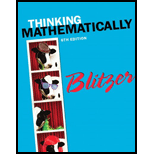
Concept explainers
In Exercises 1-6, let p, q, and r represent the following simple statements:
p: The temperature is below 32°.
q: We finished studying.
r: We go to the movies.
Express each symbolic compound statement in English. If a symbolic statement is given without parentheses, place them, as needed, before and after the most dominant connective and then translate into English.
Want to see the full answer?
Check out a sample textbook solution
Chapter 3 Solutions
Thinking Mathematically plus NEW MyLab Math with Pearson eText -- Access Card Package (6th Edition)
Additional Math Textbook Solutions
Pathways To Math Literacy (looseleaf)
Precalculus
College Algebra (Collegiate Math)
Elementary Statistics ( 3rd International Edition ) Isbn:9781260092561
APPLIED STAT.IN BUS.+ECONOMICS
Elementary Statistics: A Step By Step Approach
- Find the saddle pointsarrow_forwardProblem #5 Section A of my math class has 110 students. Section B of my math class has 80 students. a). If I randomly select 15 students from the combined classes, in a way that the order of my selection does not matter, what is the probability that all 15 students can from Section A? b). If I randomly select 15 students from the combined classes, in a way that the order of my selection does not matter, what is the probability that all 15 students can from Section B? c). If I randomly select 15 students from the combined classes, in a way that the order of my selection does not matter, what is the probability that all 7 students come from section A and 8 students come from section B?arrow_forwardProblem #6 A special passcode to unlock your phone consists of 4 digits where repeated digits are not allowed. If someone were to randomly guess a 4 digit passcode, what is the probability that they guess your passcode on the first try?arrow_forward
- Problem #3 If a card is picked at random from a standard 52-card deck, what is the probability of getting a black card or a queen?arrow_forwardProblem #1 In the 2010 census, it was reported that the United States had a population of 310 million people. Of those, 74 million were under the age of 18. If you chose a person from the U.S. population at random, what is the probability they are under the age of 18? Problem #2 Given a set S={1, 2, 3, 4, 5, 6, 7, 8, 9, 10}, if you were choosing a number at random what is the probability that you would choose an even number or a number larger than 7?arrow_forwardAnswer number twoarrow_forward
- Answer number onearrow_forwardFor the curve defined by r(t) = (e** cos(t), et sin(t)) find the unit tangent vector, unit normal vector, normal acceleration, and tangential acceleration at t = πT 3 T (1) N Ň (1) 133 | aN = 53 ar = = =arrow_forwardFind the tangential and normal components of the acceleration vector for the curve - F(t) = (2t, −3t³, −3+¹) at the point t = 1 - ā(1) = T + Ñ Give your answers to two decimal placesarrow_forward
 Algebra: Structure And Method, Book 1AlgebraISBN:9780395977224Author:Richard G. Brown, Mary P. Dolciani, Robert H. Sorgenfrey, William L. ColePublisher:McDougal Littell
Algebra: Structure And Method, Book 1AlgebraISBN:9780395977224Author:Richard G. Brown, Mary P. Dolciani, Robert H. Sorgenfrey, William L. ColePublisher:McDougal Littell Elementary Geometry For College Students, 7eGeometryISBN:9781337614085Author:Alexander, Daniel C.; Koeberlein, Geralyn M.Publisher:Cengage,
Elementary Geometry For College Students, 7eGeometryISBN:9781337614085Author:Alexander, Daniel C.; Koeberlein, Geralyn M.Publisher:Cengage,

